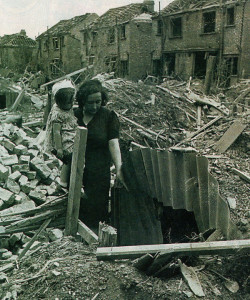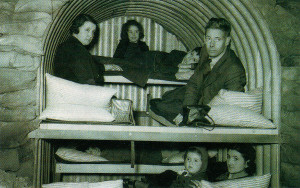 The Elwin family didn’t go in for a lot of status symbols. But, even if I say so myself, our air raid shelter was quite impressive.
The Elwin family didn’t go in for a lot of status symbols. But, even if I say so myself, our air raid shelter was quite impressive.
For the first part of the Blitz, we sheltered in the cupboard under the stairs and then, for a brief while, under the grand piano. Once it became apparent that Goering was going to persist with his nasty little habits, it was clear a longer-term sheltering strategy was called for.
Mr Elwin Senior decided on a shelter in the garden. The first man came to dig the biggest hole I had ever seen although, later on, the Germans made some even larger ones. Others came with bricks and a concrete mixer, fascinating men with collar-less shirts and rolled sleeves and waistcoats. Wearing big boots and string round their trousers, they smoked Nosegay cigarettes and swore when they thought I wasn’t listening.
When I brought all my little chums round to see it the finished work, they were visibly impressed. Ron Cardigan said: “Blimey”, which was praise indeed since he normally didn’t say anything.
The shelter was half below ground and half above. It was brick built with a thick solid concrete roof and the spoil from the hole was stacked round the walls. We grew nasturtiums on the side nearest
the entrance but the other side was out of the sun and nothing grew there so I used it to train my toy soldiers in mountain warfare.
I could clamber up on to the flat top of the shelter and I used it as an observation platform. Later in the war, I spotted doodle-bugs from up there but at this initial stage it was usually the bridge of HMS Hood or the launching point for my parachute jumps.
Once the shelter was completed, the Elwin family’s Blitz routine was significantly modified. If the siren had not sounded by bed-time, we all went up the stairs to bed. I was sent first so I usually got a bit of shut-eye before the air raids started.
When the siren sounded we wrapped ourselves in blankets and trooped out to the shelter, each carrying what we considered to be essential equipment. I usually took my army ambulance complete with stretcher bearers, nurse and wounded soldier on a stretcher.
Heating in the shelter was by a Valor stove that burned paraffin. Its oily smell and the reassuring pattern it shone on the ceiling remain vivid memories. We also had a paraffin storm lantern for lighting.
The shelter was furnished with two double bunks, solidly built with webbing straps hung between the sides to support the occupant. Those straps tended to cut into you after the first half hour and, if you were in the bunk all night, you had flesh markings like a zebra in the morning.
I was assigned one of the top bunks. I used to lay there looking up at the concrete roof about 18 inches from my nose and reflect that there was only about 12 inches of concrete between me and all the nastiness going on outside. Personally, I didn’t think that it was enough.
The shelter had a wooden door but no door frame and the last one into the shelter had to drag the door into place. If a big bomb dropped anywhere near, the door fell over in the blast.
The shelter was quite sophisticated by the standards of the day. At one end was an emergency exit. One layer of bricks in the emergency hatch was laid in sand and only the outer layer was embedded in mortar. This was to make it easier to break out if the doorway was blocked. We had a broken garden spade down there to dig ourselves out with.
Other essential equipment was the candle holder and the Bryant and May matches. You couldn’t leave the matches down there or they went damp and wouldn’t strike. Between the bunks was our card table on which the essential equipment was stored. This included a small tube of Horlicks tablets which was the nearest you could get to off-the-ration sweets during the war.
The shelter had a small lobby with a sump hole covered by a couple of small planks. The lobby was where urgent calls of nature were attended to with the help of a galvanised iron bucket.
 My old Dad used to take charge in the shelter during the air raids. He was the street ARP Warden as well but his official tin hat with a big W’ painted on it irritated his bald spot so he usually wore his trilby hat instead. He would stand in the lobby of the shelter wanting to do something useful but uncertain what. I remember the time they dropped bombs down Springhurst Rise. Each one made a whoosh and a bang and each one made a bigger whoosh and a bigger bang than the last. The shelter door blew down and gusts of warm dusty air rushed in.
My old Dad used to take charge in the shelter during the air raids. He was the street ARP Warden as well but his official tin hat with a big W’ painted on it irritated his bald spot so he usually wore his trilby hat instead. He would stand in the lobby of the shelter wanting to do something useful but uncertain what. I remember the time they dropped bombs down Springhurst Rise. Each one made a whoosh and a bang and each one made a bigger whoosh and a bigger bang than the last. The shelter door blew down and gusts of warm dusty air rushed in.
Dad stood there muttering “Don’t panic, don’t panic”. But the rising note in his voice made me realise for the first time in my life that there were some things that even Dads couldn’t sort out. A Dornier with a full bomb rack was one of them.
The old shelter served us well. It saw us through the big Blitz, the little Blitz, the incendiary raids and then through the doodle bugs and the V2’s. After the war it served as a coal bunker and, at one stage, we grew mushrooms in it.
In later more peaceful times, families were to go in for barbecue areas and patios or swimming pools to enhance their gardens. Before the war, the Elwin’s only garden furniture was the clothes prop – but the air raid shelter was without doubt our finest-ever status symbol. And useful too!
Robert Elwin








